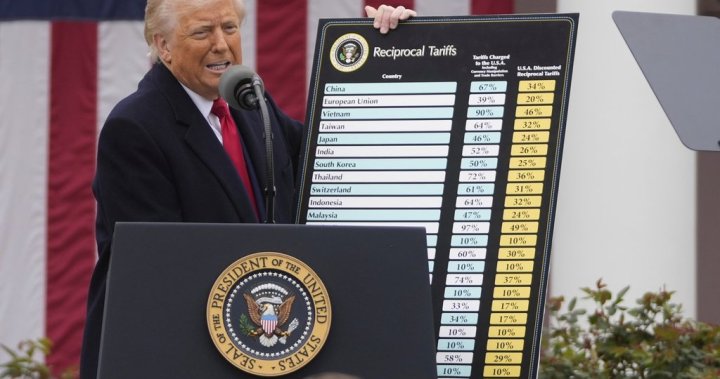On what United States President Donald Trump called « Liberation Day », the American leader imposed his so-called « reciprocal » fare policy on dozens of foreign nations.
As he made his announcement, Trump also referred to a historical law called Smoot Hawley Act of 1930, which stated that he would have saved the United States from the Great Depression if he was not eliminated.
Facing checks quickly precipitated to govern whether the law increased or not to depress or not the United States economy, while social networks were quickly flooded with classic film clips The Ferris Bueller free day, With the protagonist in class learning about the act, with his teacher blaming the then president of the act of President Herbert Hoover to worsen the great depression.
George Buri, a history professor at the University of Manitoba, does not agree with this statement, saying that its effects were quite negligible.
Buri, who gave birth to the scenes of the famous film scene, Buri reveals that Ben Stein, the actor who performed Buellers, was a free market economist and a conservative before becoming comic book. During the film’s production, he was told to give a boring lesson by the director.
A movie still from the 1986 movie « Ferris Bueller’s Day Off ».
Gettyimages
Buri is interesting to give this conference, because it is a direct reflection of what was preached during the 1980’s in the time of Thatcher and Reagan, a time when Keynesian policies and government intervention were seen as something of the past. Buri believed that it was a lack of demand that led to the great depression, not the rates.

Get Weekly Money News
Get information from experts, Q&A on topics, housing, inflation and personal finance information provided every Saturday.
« So these politicians try to argue essentially in the 1980’s, the correct economic policies they prefer to return to open markets, Laissez Faire and free trade. They basically seek to say that rates are always bad, » he said.
« In the 1980’s there is this new theory that really caused depression was not Laissez Faire, so they must have been the Smoot Hawley rates »
The new regulations and capital investments of the administration of the then President Franklin D. Roosevelt rescued the banks and established social welfare systems, helping to end the Great Depression.
In the meantime, Hoover’s rates were found as a failure to improve the economy. Since there was such a low demand in various sectors, the rates that aimed to encourage the North -Americans to buy cheaper domestic goods were not worthless because prices were already so low. From 1928 to 1933, a wheat price dropped from 1.29 to 34 cents.
Although they created difficult conditions in Canada, the wider effects of the Great Depression were much larger than the Smoot Hawley rates.
Ottawa even sought to overcome the gap through the reciprocal rates in response, but they were finally unsuccessful. Buri says it was the North -American recovery that helped the natural resource system integrated to increase, while war production in the late 1930’s rapidly increased the demand for materials and ended the Canada’s financial crisis.
Although the rates seemed to play a negligible role during depression, they were the spark that turned on the northern nations.
After Britain finished his preferential exchange with the imperial colonies, Upper and Lower Canada, as well as Nova Scotia and Nou Brunswick, began to negotiate with their neighbors in the south. However, these relationships were complicated when the United States implemented tariffs in 1866 after Britain provided support for cotton and the rich sugar confederation in the North -American Civil War.
« This is literally what Canada is born, » said Buri.
« In 1866, America ends the reciprocity, and next year in 1867 UPper and Lower Canada, Nou Brunswick and Nova Scotland decide to form the current Canada based on this new notion of: » We cannot trade with Britain, we cannot trade with the United States, why not sell each other with one another and form a larger entity? « »
Once the country has been formed, Buri states that the east-west expansion was fed by the rates implemented by John A. Macdonald, forcing Canadians to trade over 49th At the same time and protect the new nation from the North -American influence.
While free trade was the motivator of economic nationalism soon, Buri claims that the movement reappeared in the 1980’s as American corporations fell to the north, a side effect that the much smaller economy of Canada is so integrated with the financial system of its southern neighbor.
Although the rates have had very different effects for both Canadians and Americans, the stories of the two nations are full of stories related to the rates that illustrate their economic policies and development. Although Buri disagrees with Trump’s methods behind the rates, the historian understands his reason.
« There is a real problem with the north -American economy, » he said.
« This is not entirely random. It is an attempt to reverse a tendency of several decades of the decrease in the manufacturing economy of America and America more and more dependent on Wall Street and the US dollar, which as we saw in 2008 could be a recipe for disasters. »
« I think America tries to address some real problems with his economy. I don’t know or not, I don’t know. »
& Copy 2025 Global News, a division of Corus Entertainment Inc.
















Leave a Reply